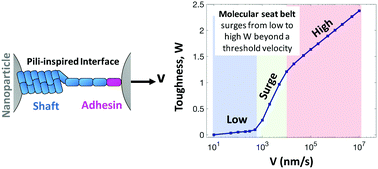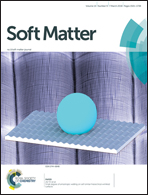Tunable seat belt behavior in nanocomposite interfaces inspired from bacterial adhesion pili
Abstract
A challenging problem in designing nanocomposites is to engineer nanoparticle interfaces that have tunable cohesive strength and rate-responsive behavior, for which inspiration can be taken from biological systems. An exemplary bio-interface is the Chaperone-Usher (CU) pili, such as type 1 expressed by bacteria Escherichia coli. The pili have unique biomechanical properties that enhance the ability of bacteria to sustain attachment to surfaces under large stresses, such as constant force extensibility, logarithmic velocity-uncoiling force dependence, and adhesive tips with catch bond behavior that exhibit longer bond life-times at greater force levels. Although biophysics of the pili under strain or stress is well-studied for anti-infective applications that aim to compromise pili adhesion, utilizing the biomechanical properties of the pili in material design applications is yet to be explored. In this work, we modeled the elongation of a single CU pilus with catch bond tip adhesin and examined its toughness response using Monte Carlo simulations. We showed that the pilus can act as a “molecular seat belt” that exhibits low toughness when pulled slowly and high toughness when pulled rapidly. Furthermore, we found that systematically varying the catch bond and shaft parameters leads to tunable seat belt behavior at the interface, where the sharpness of the transition from the low toughness to the high toughness regime and the velocity at the start of the transition can be dictated by molecular design parameters. Lastly, we tested the performance of CU pilus in slowing down a fast particle, and reveal that pili can effectively stop micron size projectiles with high initial velocities. The molecular seat belt mechanism presented here provides insight into how nanocomposite interfaces can be engineered to create molecular networks with linkers that switch on or off depending on strain rate.



 Please wait while we load your content...
Please wait while we load your content...